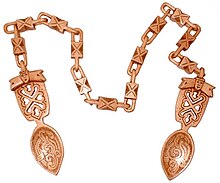|
Lovespoon A lovespoon is a wooden spoon decoratively carved that was traditionally presented as a gift of romantic intent. The spoon is normally decorated with symbols of love, and was intended to reflect the skill of the carver. Due to the intricate designs, lovespoons are no longer used as functioning spoons and are now decorative craft items. OriginsThe lovespoon is a traditional Welsh craft that dates back to the seventeenth century. Over generations, decorative carvings were added to the spoon and it lost its original practical use and became a treasured decorative item to be hung on a wall. The earliest known dated lovespoon from Wales, displayed in the St Fagans National History Museum near Cardiff, is from 1667, although the tradition is believed to date back long before that.[1] The earliest surviving example of a lovespoon worldwide originates from Germany, and is dated as 1664.[2][3] SymbolsThe lovespoon was given to a young woman by her suitor, to prove to her father that he was capable of woodworking and providing for the woman and their future family. Sailors would often carve lovespoons during their long journeys, which is why anchors would often be incorporated into the carvings.[citation needed] Certain symbols came to have specific meanings: a horseshoe for luck, a cross for faith, bells for marriage, hearts for love, a wheel supporting a loved one and a lock for security, among others. Caged balls indicated the number of children hoped for. Other difficult carvings, such as chains, were as much a demonstration of the carver's skill as a symbolic meaning.[4] Today lovespoons are given as wedding and anniversary gifts, as well as birthday, baby gifts, Christmas or Valentine's Day gifts. They are now mostly seen as a folk craft. Linked spoons  In old times, from the mid 19th-century to the early 20th-century newly married couples in Norway ate with linked spoons during the second day of the wedding ceremony to symbolize the linkage of their marriage. Often the spoons and chain were made from a single piece of wood, emphasizing wood-carving craftsmanship. After the wedding the spoons were hung above the door into their house. Similar linked spoons can be found in some ethnographic museums.[5] A design for making linked spoons was published in Popular Science[6] in 1967. See alsoReferences
Further reading
External links |